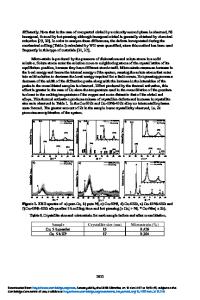Reduction of copper oxide with graphite by mechanical alloying
- PDF / 475,792 Bytes
- 8 Pages / 612 x 792 pts (letter) Page_size
- 15 Downloads / 344 Views
MATERIALS RESEARCH
Welcome
Comments
Help
Reduction of copper oxide with graphite by mechanical alloying L. Liu,a) T.J. Zhang, and K. Cui The State Key Lab of Plastic Forming Stimulation and Die & Mould Technology, Department of Materials Science and Engineering, Huazhong University of Science & Technology, 430074 Wuhan, People’s Republic of China
Y.D. Dong Institute of Materials, Shanghai University, Yanchang Road 149, Shanghai 200072, People’s Republic of China (Received 3 November 1998; accepted 23 July 1999)
The reduction of CuO with different amounts of C (CuO:C ⳱ 2:1, 2:1.5, and 2:2 molar ratios) driven by mechanical alloying was examined by x-ray diffraction and transmission electron microscopy. It was found that reduction behaviors are closely related to the carbon content. The reduction of CuO for the mixture with 1 mol of carbon follows a two-step process; i.e., CuO → Cu → Cu2O. However, the CuO can be completely converted to Cu for the mixtures with higher carbon content. A tentative model in terms of solid-state reactions at the interfaces is proposed to explain the effect of carbon content. Additionally, the thermal responses of the premilled mixtures were investigated by thermogravity and differential thermal analysis followed by x-ray identification. Contrary to mechanical alloying, reduction of CuO during thermal treatment follows a transition sequence of CuO → Cu2O → Cu. The preferential formation of Cu2O at the early annealing stage is probably due to the involvement of gaseous reduction.
I. INTRODUCTION
Mechanical alloying (MA) is basically a dry, highenergy ball-milling process which was primarily devoted to the production of oxide disperse strengthening superalloys (ODS) with fine controlled microstructures.1,2 The scope of this technique has been largely widened since the discovery that amorphization can occur in a number of systems by ball milling of elemental mixtures or grinding of intermetallic compounds.3–5 In addition to amorphous materials, a variety of metastable alloys and phases have also been successfully synthesized by this simple technique in the last decade. These include supersaturated solutions and quasicystalline and nanocrystalline materials.6–8 Mechanoreduction of metal oxides is a recent extension of the conventional mechanical alloying process, in which metals can be reduced from their oxides by using the more reductive elements.9–14 The kinetics of the reduction process was found to be closely related to the milling parameters such as collision energy and fre-
a)
Address all correspondence to this author. e-mail: [email protected]
4062
http://journals.cambridge.org
J. Mater. Res., Vol. 14, No. 10, Oct 1999 Downloaded: 22 Mar 2015
quency, as well as the thermodynamic properties of the reactions. A self-sustaining combustion process is usually achieved if the reaction enthalpy is sufficiently high. Otherwise the reduction will be controlled by a progressive process if the enthalpy is relative small or a milling agent is used. Most mechanoreductions of oxid
Data Loading...











